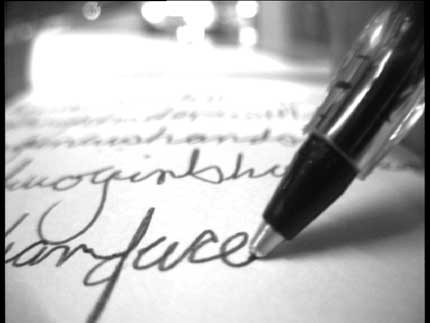| Writing (version 2) | |||
The performer sits in a public space. Equipped with video camera, pen and paper he watches and attempts to document his surroundings, in real time, through the act of writing. The video camera records the inscription. The second writing work investigates the process of the continuous capture within the act of recording. There is no space between the words in this inscription. Just as the camera continuously records, the performer also attempts to notate in an uninterrupted fashion. This results in a text void of word separation which references the early writing style of Scriptura Continua (Saenger, 1997).1 There are two points from Scriptura Continua that have influenced Writing version 2. The first, as described above, is the continuous inscription void of word separation where the act of writing becomes analogous to how the camera records information. The camera’s recording of information occurs in a linear temporal fashion where events and non-events make their mark on the recorded surface of the tape (video track).2 I was interested in referencing this temporal continuum through the omitting of word separation in the text and in doing so creating a visual reference to the continuous capture of the recording process. The second point is concerned with a slowing down of the process of spectatorship. In order for the spectator to gain meaning from the continuous text they must actively engage and decipher the words, amounting to a cumbersome method of retrieving information.3 This slowing down of spectatorship is essentially a by-product of the spectator engaged in an act of translation. Meaning is not passively provided, it must be uncovered, created and completed by the spectator. Such a process of active spectatorship in the writing work was also partially influenced by certain Fluxus films (Blink 1966, 2:20 min, by John Cavanaugh) where through imposed physiological involvement experienced in the viewing of the film, the spectator’s response became an integral part of the work. Hannah Higgins describes the viewer’s engagement with, and responses to such films as performative. It is the active process of spectatorship that is associated with a performative action by Higgins who states that “The effort to make this happen can be described as the performative element of all fluxus work: the audience has to do something to complete the work”(Higgins, 2002, p. 25). Writing version 2 aspires to a similar performative involvement from the spectator in the decoding process of the unseparated text. Furthermore it was my intention to physically augment such performative involvement through the possible introduction of sub vocal activity (mumbling) derived from the spectator deciphering the continuous inscription. Studies have found that the reading of unseparated text as well as promoting an “increase in cognitive activity also produces physiological reactions associated with sub vocal activity” (Saenger, 1997, p. 5). The body, in order to decode the unseparated text, leans towards the properties of the voice for reconstruction of meaning. I was interested in exploring the potential of sub vocal activity emanating from the spectator as a performative action, where the viewing of a screen is designed to elucidate a physiological (sub vocal and aural) response from the spectator. However in reality the sub vocal activity was minimal and did not necessarily contribute sonically to the installation (possibly due to the nature of the work being viewed in public thereby censoring the spectators physiological reactions). Regardless it provided a glimpse into the performative possibilities of this work through the active engagement demanded from the spectator. 1. Scriptura Continua eventuated in Greek writings of Antiquity. It is said to have stemmed from when the Greeks adopted the Phoenician alphabet and added symbols for vowels. “After the introduction of vowels, word separation was no longer necessary to eliminate an acceptable level of ambiguity” (Saenger, 1997, p. 9).
|
|
||
Writing version 2 |
|||
| Return to Writing works | |||
